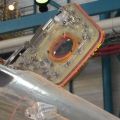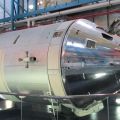For the Apollo spacecraft aslo needed was a three-man vehicle designed for Earth orbital, translunar, and lunar orbital flight, and return to Earth. This consisted of a command module supported by a service module, built by North American Aviation (later North American Rockwell).

The Command Module (CM) (with a cone shape seen left in the drawing) had its position on top of Saturn V. It functioned as the control center for the Apollo spacecraft and living quarters for the three crewmen. It contained the pressurized main crew cabin, crew couches, control and instrument panel, Primary Guidance, Navigation and Control System, communications systems, environmental control system, batteries, heat shield, reaction control system, forward docking hatch, side hatch, five windows and the parachute recovery system. It was the only part of the Apollo/Saturn space vehicle that returned to planet Earth intact. When landed at Sea with the parachutes, the astronaut crew was recovered and often frogmen were dropped with the Seaking Helicopter operated from a nearby carrier and the crew winched aboard.
The Service Module (SM) (seen aft of the CM in the drawing) was unpressurized and contained a main service propulsion engine and propellant to enter and leave lunar orbit, a reaction control system to provide attitude control and translational capability, fuel cells with hydrogen and oxygen reactants, radiators to dump waste heat into space, and a high gain antenna. The oxygen was also used for breathing, and the fuel cells produced water for drinking and environmental control. On Apollo 15, 16 and 17 it also carried a scientific instrument package, with a mapping camera and a small sub-satellite to study the moon. A major portion of the service module was taken up by propellant and the main rocket engine. Capable of multiple restarts, this engine placed the Apollo spacecraft into and out of lunar orbit, and was used for mid-course corrections between the earth and the moon. The Service Module remained attached to the Command Module throughout the mission. It was jettisoned just prior to reentry into the Earth's atmosphere.
Photo's from various other displays at the Kennedy Space Center (Florida, USA) in two galleries below....
Photographed, February 2012 by Cees Hendriks (C) Copyright IPMS Nederland
Lunar Service Module with also the Command Model cone seen as well......
COMMAND MODULE (recovered and from the Apollo 14)...
Several scale models exits of these modules in various modelling scales. Revell has a very nice 1/32 scale model of the CM and SM combined. Also various ready made scale desktop models exist.

































